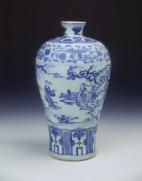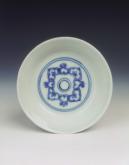6. Blue-and-White
Chinese ceramics had been travelling to Asia and the Middle East in small quantities from as early as the Han dynasty (206 BCE - 220 CE), and were being exported in systematic, commercial shipments from at least the Southern Song (1127-1278) onwards. However, the establishment of the Yuan dynasty (1279-1368) and massive land-based Mongol Empire, which at its height stretched from Japan through the Middle East and as far as Poland and Hungary, created uniquely favourable conditions for the export of ceramic objects on a much larger scale. Persian potters had for many years been trying to decorate plain ceramic wares with blue cobalt, but the glazes on their domestic ceramics had proved unsuitable. Jingdezhen potters began during the thirteenth century to add cobalt blue designs to their own wares, probably at the behest of the large Muslim trading communities that existed in Quanzhou and other Chinese merchant cities. From around the turn of the fourteenth century, Chinese potters were regularly importing large quantities of cobalt oxide from Persia, and using it to produce ceramic wares which were then sent back to Middle Eastern markets.
The simple combination of blue on white proved popular around the world, and Chinese porcelain decorated in this manner became perhaps the very first truly global brand. Examples of blue-and-white have been found in East African mosques, Peruvian cathedrals and the excavated site of a Prague hospital. Shipwreck sites as far away as California and Australia attest to an even wider spread of what Samuel Johnson (1709-1784) described as ‘the contagion of China-fancy.’
Among the pieces displayed here is a dish dating from the Chenghua 成化 reign period (1465-1487) , often considered by later connoisseurs to represent the pinnacle of blue-and-white production. A late-Ming taste manual written in 1635 by Liu Tong 劉侗 (c. 1593-1637) reserves high praise for such early-Ming pieces, while advising collectors to stay away from anything contemporary. This commonly-held prejudice helps to explain why many later Ming and early-Qing pieces imitate the styles and designs of earlier periods.
, often considered by later connoisseurs to represent the pinnacle of blue-and-white production. A late-Ming taste manual written in 1635 by Liu Tong 劉侗 (c. 1593-1637) reserves high praise for such early-Ming pieces, while advising collectors to stay away from anything contemporary. This commonly-held prejudice helps to explain why many later Ming and early-Qing pieces imitate the styles and designs of earlier periods.
Previous Page / Next Page


BATEA 146. © MEAA.

BATEA 144. © MEAA.
 , often considered by later connoisseurs to represent the pinnacle of blue-and-white production. A late-Ming taste manual written in 1635 by Liu Tong 劉侗 (c. 1593-1637) reserves high praise for such early-Ming pieces, while advising collectors to stay away from anything contemporary. This commonly-held prejudice helps to explain why many later Ming and early-Qing pieces imitate the styles and designs of earlier periods.
, often considered by later connoisseurs to represent the pinnacle of blue-and-white production. A late-Ming taste manual written in 1635 by Liu Tong 劉侗 (c. 1593-1637) reserves high praise for such early-Ming pieces, while advising collectors to stay away from anything contemporary. This commonly-held prejudice helps to explain why many later Ming and early-Qing pieces imitate the styles and designs of earlier periods. 


